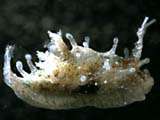
Okenia zoobotryon
(Smallwood, 1910)
Order: NUDIBRANCHIA
Suborder: DORIDINA
Superfamily: ANADORIDOIDEA
Family: Goniodorididae
DISTRIBUTION
Western Atlantic (Caribbean region). Possible records also from Canary Islands, Brazil, and Australia, but as discussed below, our knowledge of this species needs to be improved before identifications can be confirmed
PHOTO
Unlocalised photo provided by the late Kerry B. Clark.
Also known by various authors as Polycerella zoobotryon, Bermudella zoobotryon, Bermudella polycerelloides, this small brown goniodorid was originally described from Bermuda (Smallwood, 1910) where it was found in large numbers on the ctenostome bryozoan Zoobotryon verticillatum (= Zoobotryon pellucidum). The rhinophores were described as having 3-6 'cup-like, equidistant folds on the posterior surface of its distal two-thirds', and the 16 - 19 dorsal and lateral papillae were described as 'clavate… the tips of which are translucent'. The dorsal papillae were arranged in a distinct pattern, with two in the midline between the gills and the rhinophores, two on either side of the midline in front of the rhinophores, two just in front of the gills and two behind the gills. There are also 4 - 6 lateral papillae on each side. From Smallwood's drawing I would consider the anterior pair of dorsal papillae to be the most anterior of the lateral papillae and the posterior pair to be the most posterior of the lateral papillae. Determining the nature of these papillae is important because the arrangement of the dorsal papillae is often a species-specific character. In a later anatomical description (Smallwood, 1912), he describes the reproductive system in some detail. Unfortunately his description, based on dissection and histological sections, doesn't seem to make sense, which is unfortunate because it means we have no knowledge of the reproductive system of this species. Clark (1984) redescribed specimens from Bermuda and reported populations from Florida. Externally his description follows Smallwood's except for the report of two dorsal papillae on each side of the pericardium, instead of a single pair. He also corrected the radula description. As I discuss in a separate message, Clark's suggestion that Okenia evelinae Marcus, 1957 is a synonym of O. zoobotryon is most unlikely, as they differ in colour, rhinophore shape and host bryozoan.. Redfern (2001) describes and illustrates the external features of animals from Bermuda and confirms they match Valdes & Ortea's (1995) illustration of a Cuban specimen which shows 2 pairs of secondary dorsal papillae as described by Clark.
I have recently reported specimens, which I tentatively identify as O. zoobotryon, from South Australia [see message #12656, Rudman, 2004] but until further information is available on the anatomy of Atlantic specimens of Okenia zoobotryon, the identification must remain tentative. In general external shape and colour they agree, and they have the characteristic cup-shape lamellae on the rhinophores, but they lack the secondary dorsal papillae which are characteristic of Atlantic specimens of O. zoobotryon. Drawings of the radular teeth (Clark, 1984; Valdes & Ortea, 1995) suggest they are very similar to the radula of Australian specimens, but it would be valuable to have information on the reproductive system. By coincidence, there is another small brown species, Okenia mija, found in Australian waters which has a similar arrangement of dorsal papillae to that of Atlantic O. zoobotryon. It differs in having papillae with pointed, rather than swollen, tips, and feeds on a related bryozoan Amathia wilsoni.
The obvious zoogeographic anomaly is not a major obstacle because its food bryozoan, the ctenostome Zoobotryon verticillatum (= Z. pellucidum) is a well-known 'tramp' species, with a worldwide distribution considered to be the result of shipping and perhaps drifting on pieces of brown algae. Okenia pellucida, also a feeder on Zoobotryon verticillatum, has a wide distribution which is also considered, at least partially, to be the result of the 'unnatural' distribution of Zoobotryon.
Based on the literature, here is a brief external description of Atlantic animals: The ground colour is translucent white with small irregularly sized and shaped spots scattered over the mantle. The foot and sides of body lack the brown spotting but may have a few small scattered opaque white spots. There can be up to 9 papillae in front of the gills and about 6 on each side along the mantle ridge. They are characteristically shaped with a relatively thin stalk and a rounded terminal bulb, compared by Valdes & Ortea (1995) with a chess pawn. The rhinophores are also uniquely shaped with 3 to 6 cup-like folds on the posterior face. It grows to about 6mm in length and in all reports in which a host has been named it as been found on the arborescent bryozoan Zoobotryon verticillatum.
-
Clark, K. B. (984) New records and synonymies of Bermuda opisthobranchs (Gastropoda). The Nautilus, 98(2): 85-97.
-
Edmunds, M. & Just, H. (1985) Dorid, dendronotoid and arminid nudibranchiate Mollusca from Barbados. Journal of molluscan Studies, 51(1): 52-63.
-
Redfern. C., (2001) Bahamian Seashells: a Thousand Species from Abaco, Bahamas. Bahamianseashells.com Inc: Boca Raton. 1-280.
-
Rudman, W.B. (2004) Further species of the opisthobranch genus Okenia (Nudibranchia: Goniodorididae) from the Indo-West Pacific. Zootaxa, 695: 1-70.
-
Smallwood, W.M. (1910). Notes on the Hydroids and Nudibranchs of Bermuda. Proc. Zool. Soc. London. 1: 137-145
-
Smallwood, W. M. (1913) Polycerella zoobotryon (Smallwood). Proceedings of the American Academy of Arts & Sciences, 47(16): 609-630.
-
Valdes, A. & Ortea, J. (1995) Revised taxonomy of some species of the genus Okenia Menke, 1830 (Mollusca: Nudibranchia) from the Atlantic Ocean, with the description of a new species. The Veliger, 38(3): 223-234.
ARCHIVE NOTE: An earlier edition of this Fact Sheet [27 January 2004] is available on request.
Authorship detailsRudman, W.B., 2004 (December 21) Okenia zoobotryon (Smallwood, 1910). [In] Sea Slug Forum. Australian Museum, Sydney. Available from http://www.seaslugforum.net/find/okenzoob
Related messages
Re: Eggs of Okenia zoobotryon
February 5, 2009
From: Leanne and David Atkinson
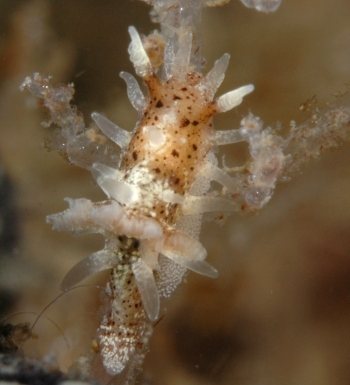
Concerning message #16798:
Dear Bill,
We found some more Okenia zoobotryon on their bryozoan Zoobotryon verticillatum after we saw eggs on it. One of them appeared to be laying eggs. In the upper picture where we are looking down from on top we think we can see on the right hand side a tiny transparent reproductive duct extruding the eggs. On this occasion we couldn't find any Okenia pellucida on the same bryozoan or any nudibranchs on the other Zoobotryon verticillatum colonies we saw with egg strings. We hope this is of interest.
Locality: Fly Point, Port Stephens-Great Lakes Marine Park, Port Stephens , 12 metres, New South Wales, Australia, Pacific Ocean, 25 January 2009, Sandy bottom with scattered sponges, bryozoans, ascidians, soft corals and gorgonians. Length: 8 mm approximately. Photographer: Leanne and David Atkinson.
Regards,
Leanne & David Atkinson
atk@hunterlink.net.au
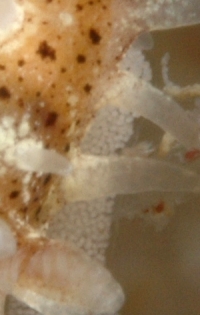
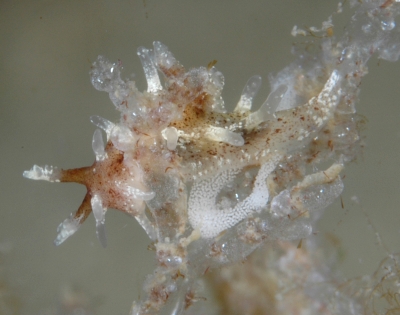
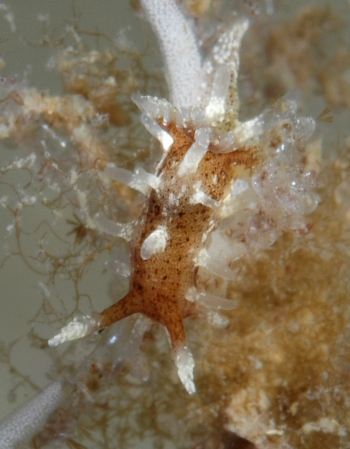
Dear Leanne and David,
I have included a close-up showing the transparent structure you refer. I suspect if it is partof the reproductive organs it is a small flap at the edge of the reproductive opening rather than a duct
Best wishes,
Bill Rudman
Re: First record of Okenia zoobotryon from Australia
February 12, 2008
From: Leanne & David Atkinson
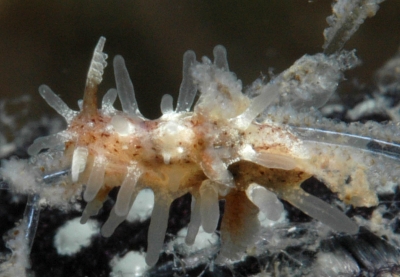
Concerning message #21336:
Dear Bill,
After reading on the Sea Slug Forum about Okenia zoobotryon feeding on Zoobotryon verticillatum with Okenia pellucida I looked hard for both nudibranchs on every Zoobotryon verticillatum that we found today. Each of the bryozoans that I looked in were hung with little white egg ribbons like Christmas decorations. On the last one we found both Okenias. Here are photos of Okenia zoobotryon. One photo [centre right: O. pellucida at top of photo] contains both spcies of Okenia. Can you confirm our identification?These photos show the animal much more clearly than the last ones we sent in.
Locality: Halifax Sponge Gardens, Port Stephens, Port Stephens-Great Lakes Marine Park, 12 metres, New South Wales, Australia, Pacific, 10 February 2008, Sandy bottom with scattered seagrasses, ascidians, bryozoans, gorgonians, soft corals and sponges. Length: 5 mm. Photographer: Leanne & David Atkinson.
Regards,
Leanne & David Atkinson
atk@hunterlink.net.au
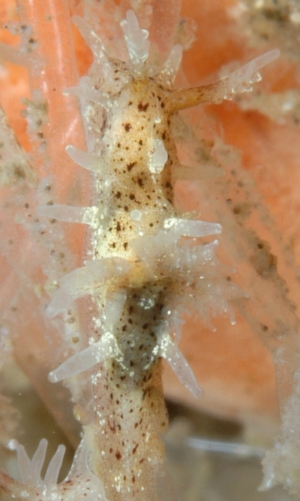
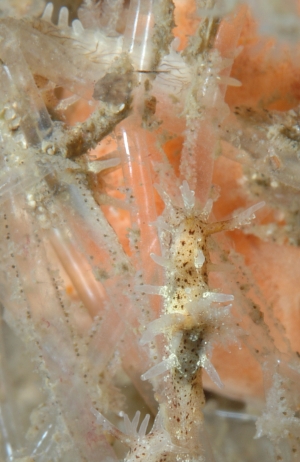
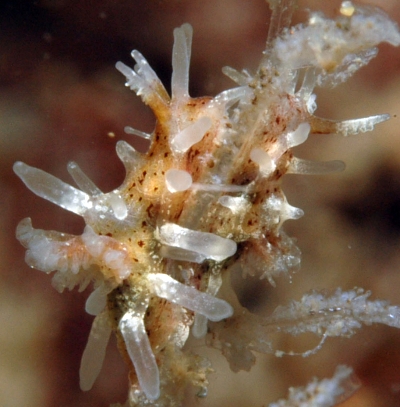
Dear Leanne & David,
Thanks for these nice photos. Yes I would say these are O. zoobotryon. The rhinophores do not have the perfect cup shape so typical of the species, but they seem to be easily damaged, as often one animal will have one good rhinophore and one damaged, or even without lamellae at all. The absence of dorsal papillae, except for two or three in the dorsal midline is one other way to separate it from O. mija which usually has quite a few extra papillae on either side of the midline.
Best wishes,
Bill Rudman
Re: First record of Okenia zoobotryon from Australia
January 31, 2008
From: Leanne & David Atkinson
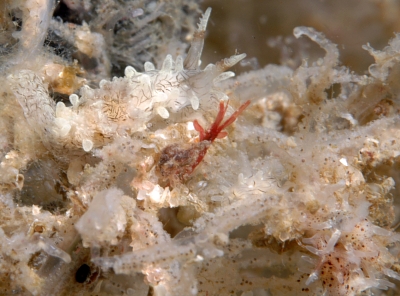
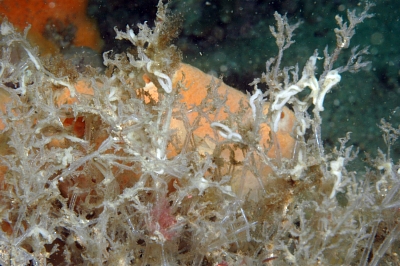
Concerning message #12656:
Dear Bill,
Following on from our message [#21335] about Okenia pellucida at Port Stephens here is a note about Okenia zoobotryon we found at the same time in the same bryozoan. The Okenia were difficult to see because they were so tiny. We used the minimum focus 1:1 of our macro lens to even see them. When we put the images on the computer it was easy to see that the host was covered with an "infestation" of Okenia pellucida. We also found in one of the 6 photos of Okenia pellucida two tiny brown spotted nudibranchs that we didn't see when we took the photo. It is not a good angle to see the details of their bodies. What we can see makes us think they are Okenia zoobotryon. We are sending the original photo uncropped and a cropped version which shows the 2 brown spotted nudibranchs. [Upper Photo: Whole photo with large O. pellucida clearly visible. Lower Photo: Closeup of lower right corner of upper photo showing brown spotted O. zoobotryon.] We've looked at the information on Okenia mija as well but these don't have the white spots or the yellowness of the body shown in the Okenia mija photos. We will keep looking to see if we can find some more.
Locality: Halifax Sponge Gardens, Port Stephens - Great Lakes Marine Park, Port Stephens, 15 metres, New South Wales, Australia, Pacific, 30 December 2007, Sandy bottom with scattered sponges, ascidians, soft corals, bryozoans and kelp. Length: 5 mm. Photographer: Leanne & David Atkinson.
Best wishes,
Leanne & David Atkinson
atk@hunterlink.net.au
Atkinson, L. & D., 2008 (Jan 31) Re: First record of Okenia zoobotryon from Australia. [Message in] Sea Slug Forum. Australian Museum, Sydney. Available from http://www.seaslugforum.net/find/21336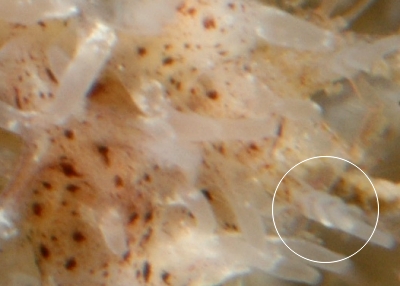
Dear Leanne & David,
Species of Okenia seem to be fairly specific in the species of bryozoan they eat and until now O. mija has only been found on Amathia wilsoni while O. zoobotryon, as its name suggests, feeds on Zoobotryon verticillatum. That is not to say that O. mija may also eat Zoobotryon verticillatum, but at present we have no evidence that it does, so you identification of these animals as O. zoobotryon is most likely correct. I must say I can't really see enough in your photos to determine the shape of the animals but I can see one rhinophore [ringed] and it appears to have the three cup-shaped lamellae which are characteristic of O. zoobotryon. The lamellae in O. mija are more numerous and have a notch in the posterior midline.
Best wishes,
Bill Rudman
Okenia zoobotryon from southeast Florida, USA
October 30, 2007
From: Linda Ianniello
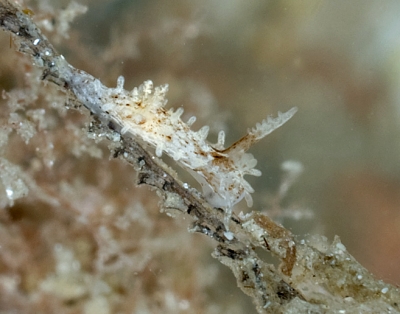
Dr. Bill,
Here is a photo of Okenia zoobotryon from our area, since you don't have any images from Florida. It was so tiny that it is not a great shot, but shows some detail of the rhinophores and gills.
Locality: Lake Worth, 20 feet, Florida, USA, Atlantic Ocean, October 14, 2007, Intracoastal waterway with strong tidal currents. Length: Less than 1/2 inch. Photographer: Linda Ianniello.
As always, thanks for the great work on the forum. It is an invaluable resource.
Regards,
Linda I.
lindai1@bellsouth.net
Ianniello, Linda M., 2007 (Oct 30) Okenia zoobotryon from southeast Florida, USA. [Message in] Sea Slug Forum. Australian Museum, Sydney. Available from http://www.seaslugforum.net/find/21015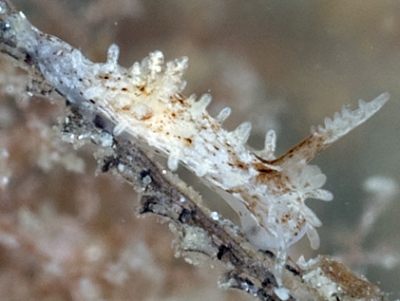
Dear Linda,
This is a very valuable find. Okenia zoobotryon was described from Bermuda but we have no good description of the external features of the species from the Caribbean. Are the lateral papillae rounded? swollen at the tips? etc etc so this is the first clear picture I have seen of a Caribbean animal. The importance of this is that it seems to have a worldwide distribution, but slight differences in descriptions from different parts of the world have left some lingering doubts about whether it is a worldwide species or whether there are a number of similar looking species in different parts of the world. Your photo certainly makes me more comfortable in identifying animals from Australia as the same species.
Best wishes,
Bill Rudman
Re: Radula of Senegalese Okenia zoobotryon [4]
June 21, 2006
From: Angel Valdes
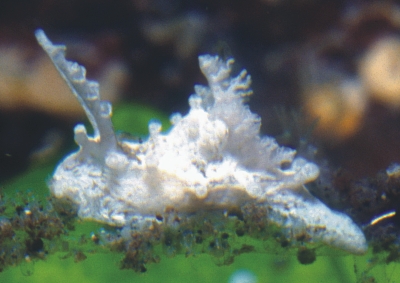
Concerning message #16891:
Dear Marina and Bill,
It is true that the animal in your photo as well as the one in the photo from Venezuela by Jeff Hamann have a small hump in front of the gill, which as Bill mention is the pericardium, but it is not nearly as pronounced as in the other species. I attached another photo by Jeff Hamann of a different specimen from Belize so you can see the difference with the latest photos you sent. There are other differences between these two species including the coloration, the length/width ratio and the general shape of the body.
Best regards,
Angel
United States
avaldes@nhm.org
Valdes, A., 2006 (Jun 21) Re: Radula of Senegalese Okenia zoobotryon [4]. [Message in] Sea Slug Forum. Australian Museum, Sydney. Available from http://www.seaslugforum.net/find/16922Thanks Angel,
There certainly seems to be two species. When I get a chance I will attempt to split "Okenia zoobotryon" into its component parts.
Best wishes,
Bill Rudman
Re: Radula of Senegalese Okenia zoobotryon [3]
June 19, 2006
From: Marina Ossokine
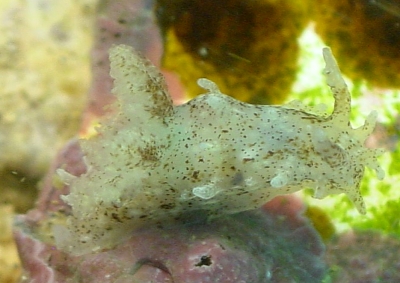
Concerning message #16883:
Dear Angel (and Bill),
Thank you to pay attention to these specimens and to comment on them.
I don't know what kind of 'hump' you are talking about, but looking closely at the many photos I have of this species, it seems they do have a lump on the back just in front of the gills. This lump is more or less visible depending on how the photos were taken.
Here are 2 shots (amongst others I have) which show it clearly.
Locality: 'Terou baye Sogui', Dakar, 4m, Senegal , Atlantic Ocean, 6 June & 30 May 2005 . Length: (3) : 10mm / (4) : 10mm . Photographer: Marina Poddubetskaia Ossokine.
Also, I think Bill aroused here a very interesting discussion. I think this kind of discussion is one of the best parts of the Forum.
All the best,
Marina.
Nembro website
nembro@nembro.info
Poddubetskaia Ossokine, M., 2006 (Jun 19) Re: Radula of Senegalese Okenia zoobotryon [3]. [Message in] Sea Slug Forum. Australian Museum, Sydney. Available from http://www.seaslugforum.net/find/16891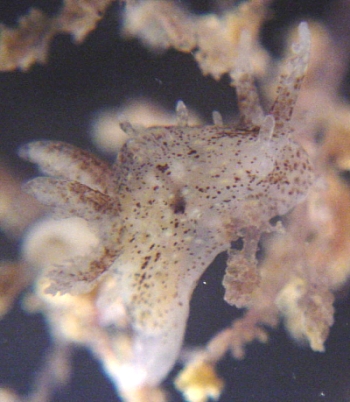
Dear Marina,
Thanks for these photos. They do seem to show the 'hump' we were talking about, which is a bit of a problem, because I thought from your other photos that you had the 'humpless' animal. The 'hump' is right over the heart and pericardial cavity, so perhaps the variation is the result of some swelling in the pericardium - perhaps through salinity changes? If so, we could be looking at some temporary physiological change rather than a genetic species-level morphological difference. One way to check this would be to collect a few specimens and keep them in a container for a few days and see if they develop or lose a swelling in front of the gills. Adding a little freshwater to the container would certainly be one way of changing the physiological conditions. Mind you, it would involve another trip to Senegal.
I am glad you enjoy these discussions. They are a good way of showing how we attempt to solve problems, and why taxonomists are usually cautious in naming 'new species' even when it seems blindingly obvious. The first step is to try and make sure the species has not been named before - and unfortunately that can sometimes be quite difficult, because in earlier times, new species descriptions were often very short of detail. The second major problem is deciding whether the animal you are looking at is indeed a new species or whether it is just a variation of an existing one. In this case we have a couple of names to use, but we can't be sure if we have two species or one.
Best wishes,
Bill Rudman
Re: Radula of Senegalese Okenia zoobotryon [2]
June 17, 2006
From: Angel Valdes
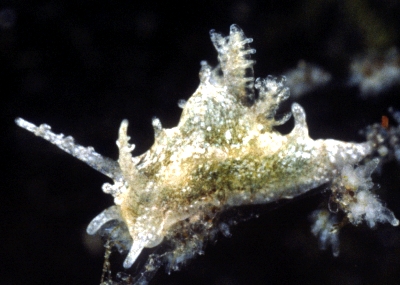
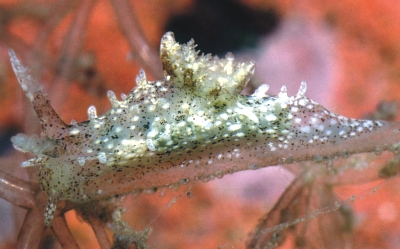
Concerning message #16883:
Dear Bill,
I think you are absolutely right. The original descriptions of Okenia zoobotryon and O. polycerelloides look identical to me and different from the species that Valdes & Ortea (1995) called O. zoobotryon, which I agree is probably a new species. You are also right that the confusion started with Clark's (1984) redescription of O. zoobotryon, based on specimens from the type locality (lower drawing - Clark, 1984: Fig 44), which clearly have a dorsal hump.
I also attached here photos of both species taken by Jeff Hamann in the Caribbean Sea. The upper photo is the one which has been mistakenly indentified as O. zoobotryon but it is likely an undescribed species - it was taken in Grand Bahama. The lower photo is the 'true' O. zoobotryon - it was taken in Venezuela
Best regards,
Angel
avaldes@nhm.org
Valdes, A., 2006 (Jun 17) Re: Radula of Senegalese Okenia zoobotryon [2]. [Message in] Sea Slug Forum. Australian Museum, Sydney. Available from http://www.seaslugforum.net/find/16889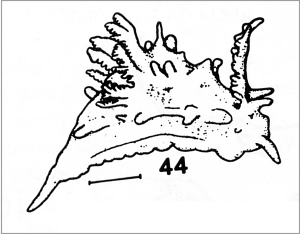
Dear Angel,
Thanks for the two photos which show the differences very well. Kerry Clark sent me a photo of his Okenia zoobotryon which is the one I have at present on the species Fact Sheet but it never looked quite right. Now that we have photos of both from the Caribbean it seems pretty clear that there are two different species. I think this photo of the 'true' Okenia zoobotryon is the first I have seen which unequivocally matches Smallwood's original description - after almost 100 years. I will now have to look at my notes on the Australian animals [message #12656] and see if they are either of these two Atlantic species.
It's wonderful to be able to resolve this problem
Best wishes,
Bill Rudman
Re: Radula of Senegalese Okenia zoobotryon
June 16, 2006
From: Angel Valdes
Concerning message #16797:
Dear Bill and Marina,
Looking at the photos of this animal from Senegal I noticed something that is not quite right. Okenia zoobotryon has a characteristic hump in front of the gill, and the dorso-lateral papillae are wider at the apex, with spherical tips. I believe the specimen from Senegal is the rare species Okenia polycerelloides (Ortea & Bouchet, 1983) originally described from the Canary Islands in the genus Bermudella.
-
Ortea, J.A. & Bouchet, P. 1983. Un nuevo Goniodoridae (Mollusca: Nudibranchiata) de las Islas Canarias. Vieraea, 12: 49-54.
Best regards,
Angel
avaldes@nhm.org
Valdes, A., 2006 (Jun 16) Re: Radula of Senegalese Okenia zoobotryon. [Message in] Sea Slug Forum. Australian Museum, Sydney. Available from http://www.seaslugforum.net/find/16883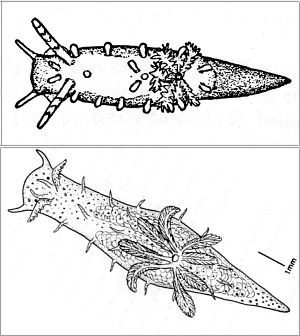
Dear Angel,
I suspect Okenia zoobotryon is going to haunt me forever. I have certainly puzzled over the median hump in front of the gills which you and others have described (Valdes & Ortea, 1995; Clark, 1984, Redfern - message #12421). That is why I have been hesitant to identify Australian animals [message #12656] and Marina's Senegalese animals as O. zoobotryon, because, as you point out, they lack this median hump. However, Smallwood's original description of O. zoobotryon gives a very detailed description of the external features, including a detailed positioning of all the papillae, and his animals did not have this median dorsal hump, which makes me wonder if the 'humped' species is not O. zoobotryon. In most features Smallwood's species is identical to Ortea & Bouchet's Bermudella polycerelloides. In fact the only difference Ortea & Bouchet note is that their new species has the usual one lateral radular tooth on each side, while Smallwood described three in O. zoobotryon. Clark 'corrected' Smallwood's apparent mistake, but if his animal is not Smallwood's O. zoobotryon we are still somewhat in the dark. However since Ortea & Bouchet's animal, and Marina's, fit Smallwood's original description I think we can be reasonably confident in saying that Smallwood's radula description is incorrect. This means there is no difference between O. zoobotryon and O. polycerelloides.
FIGURES: Upper right: Polycerella zoobotryon Smallwood, 1919: Fig 10. Lower right: Bermudella polycerelloides Ortea & Bouchet, 1983: Fig. 1A. [scans from original descriptions].
If my argument is correct, then it means that the Okenia with a median hump is unnamed. One other species synonymised with Okenia zoobotryon by Clark, which might have been available as a replacement name, is O. evelinae Marcus, 1957, but as I have shown before on the Forum [message #12043], that it is quite a different species.
I thought at one stage that the Australian O. mija might be this species - a wordwide tramp species - but it doesn't have a convincing median hump and the cup-shaped lamellae on the rhinophores have a median notch. It's unfortunate that the two names O. zoobotryon and O. polycerelloides can't be used for the two species, but as luck would have it I think they both apply to the same species. The error seems to have arisen from Clark's revision.
-
Clark, K. B. (1984) New records and synonymies of Bermuda opisthobranchs (Gastropoda). The Nautilus, 98(2): 85-97.
- Redfern. C., (2001) Bahamian Seashells: a Thousand Species from Abaco, Bahamas. Bahamianseashells.com Inc: Boca Raton. 1-280.
-
Rudman, W.B. (2004) Further species of the opisthobranch genus Okenia (Nudibranchia: Goniodorididae) from the Indo-West Pacific. Zootaxa, 695: 1-70.
-
Smallwood, W.M. (1910). Notes on the Hydroids and Nudibranchs of Bermuda. Proc. Zool. Soc. London. 1: 137-145
-
Smallwood, W. M. (1913) Polycerella zoobotryon (Smallwood). Proceedings of the American Academy of Arts & Sciences, 47(16): 609-630.
-
Valdes, A. & Ortea, J. (1995) Revised taxonomy of some species of the genus Okenia Menke, 1830 (Mollusca: Nudibranchia) from the Atlantic Ocean, with the description of a new species. The Veliger, 38(3): 223-234.
Let me know what you think
Best wishes,
Bill Rudman
Eggs of Okenia zoobotryon
June 9, 2006
From: Marina P. Ossokine
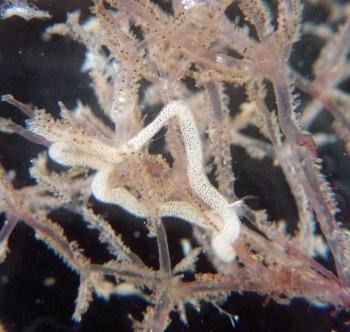
Dear Bill,
In addition to my previous message [#16797], here are the photos of an egg-ribbon produced by Okenia zoobotryon.
Locality: 'Cap Manuel', Dakar, 5m, Senegal , Atlantic Ocean, 2 June 2005. Photographer: Marina Poddubetskaia Ossokine.
Best wishes,
Marina.
Nembro website
nembro@nembro.info
Poddubetskaia Ossokine, M., 2006 (Jun 9) Eggs of Okenia zoobotryon. [Message in] Sea Slug Forum. Australian Museum, Sydney. Available from http://www.seaslugforum.net/find/16798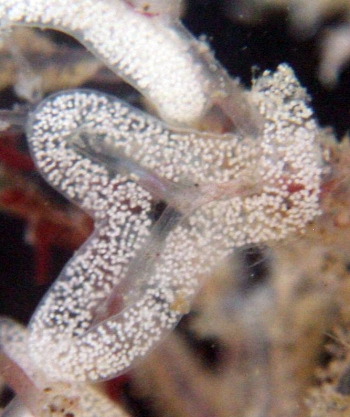
Thanks Marina,
Glad to see the eggs are deposited on the ctenostome bryozoan Zoobotryon verticillatum, which is the preferred food of this species.
Best wishes,
Bill Rudman
Radula of Senegalese Okenia zoobotryon
June 9, 2006
From: Marina P. Ossokine
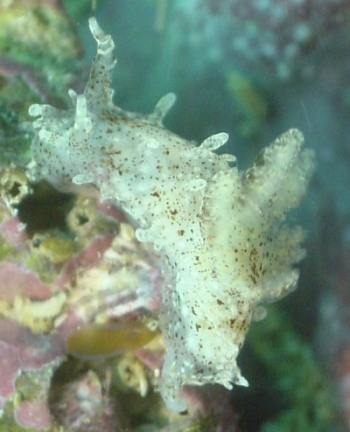
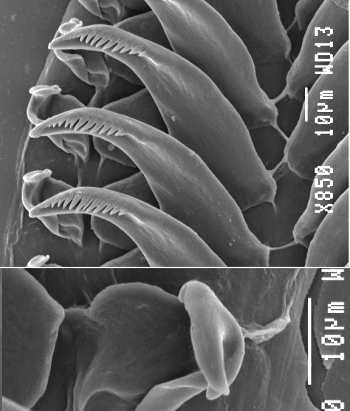
Dear Bill,
I'd like to dust off an old discussion on Okenia zoobotryon from Senegal. In 2004 you suggested this identification but with some hesitation because of the tubercle shape [message #10265 ].
During my 2005 stay in Senegal I saw this species in large numbers at several shallow sites, but always on the same bryozoan. So, I decided to check the radula of this species to see if the marginal tooth does have 2 cusps. The confirmation follows in attached here SEM photos...
Locality: Upper photo: Terou baye Sogui, 4 m, 10 mm long alive. Lower photo: Cap Manuel, Dakar, 5m, 8 mm long alive. Senegal , Atlantic Ocean, 2-6 June 2005 . Photographer: Marina Poddubetskaia Ossokine.
Moreover, I add here a close-up of the head which shows well the velum with (only) two appendages, as described in Valdes & Ortea's (1995) paper.
Also, I'm sending the photos of the related egg-mass in a separate message [#16798 ].
Best wishes,
Marina.
Nembro website
nembro@nembro.info
Poddubetskaia Ossokine, M. , 2006 (Jun 9) Radula of Senegalese Okenia zoobotryon. [Message in] Sea Slug Forum. Australian Museum, Sydney. Available from http://www.seaslugforum.net/find/16797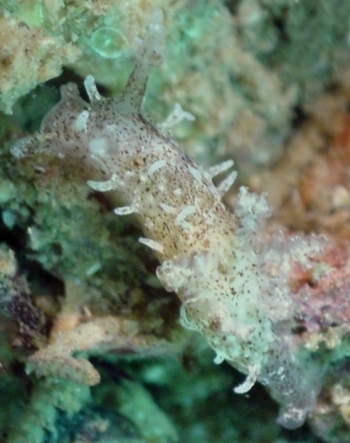
Dear Marina,
Thanks for this valuable information. Certainly your animals look like others on the Forum from the western Atlantic and fit the original description of O. zoobotryon. In general shape and radular morphology they seem a bit different from the animals from Australia which I have identified as that species [message #12656], but they all have the characteristic three 'cup-shaped' lamellae on the rhinophores.
It certainly adds to our knowledge of the species.
Best wishes,
Bill Rudman
Okenia zoobotryon from Venezuela
April 11, 2005
From: Sylvia Grune
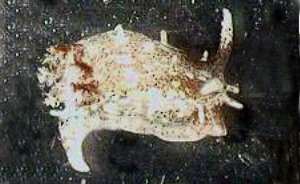
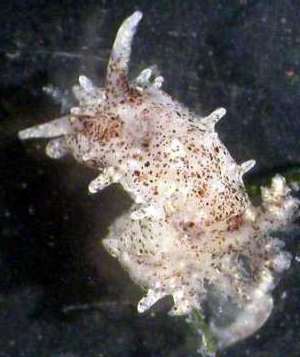
Hi Bill,
We found and identified Okenia zoobotryon in a hypersaline lagoon called Laguna de la Restinga on Margarita Island, Venezuela. I would like to send you the pictures of the specimen so you can confirm the identification
many thanks for your help! GOOD work!
Locality: Laguna de la Restinga, Margarita Island, Nueva Esparta, Venezuela, Caribbean. Depth: 5 m. December 2004. Photographer: Jesus Henrique Hernandéz
Sylvia Grune
sylvia_grune@yahoo.com.mx
Grune, S., 2005 (Apr 11) Okenia zoobotryon from Venezuela. [Message in] Sea Slug Forum. Australian Museum, Sydney. Available from http://www.seaslugforum.net/find/13487Dear Sylvia,
This certainly looks like the photo Kerry Clark sent to the Forum of Okenia zoobotryon [#169]. It would be nice to see the detail of the rhinophores, because in this species there are a few cup-shaped structures rather than a series of flattened lamellae.
Best wishes,
Bill Rudman
Okenia zoobotryon from the Bahamas
December 22, 2004
From: Colin Redfern
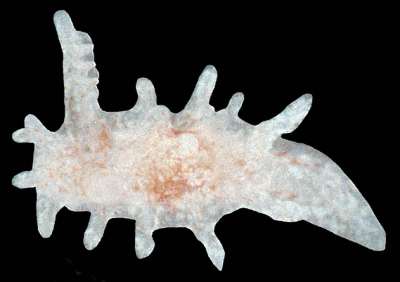
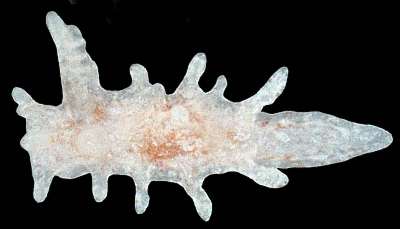
Dear Bill,
To contribute to your discussion of Okenia zoobotryon, I'm sending two photos of the only specimen that I have seen from Abaco, Bahamas. The 2.5 mm animal was collected from floating Sargassum. Presumably some Zoobotryon verticillatum was attached to the Sargassum, but I didn't actually observe any.
An additional reference for O. zoobotryon is Jensen & Clark (1986), who included a line drawing and color photo of this species from Bermuda. In a separate message [message # ] I am sending photos of Okenia impexa.
Photos: 2.5mm. Collected from floating Sargassum off Guana Cay, Abaco, Bahamas. June 29, 1997.
-
Jensen, R.H. & K.B.Clark. 1986. Class Gastropoda (snails, limpets and slugs). In: Marine Fauna and Flora of Bermuda, pp. 397-458. W.Sterrer, editor. John Wiley & Sons: New York.
Best wishes,
Colin
bahamianseashells@att.net
Redfern, C., 2004 (Dec 22) Okenia zoobotryon from the Bahamas. [Message in] Sea Slug Forum. Australian Museum, Sydney. Available from http://www.seaslugforum.net/find/12421Thanks Colin,
All additional information is very welcome,
Best wishes
Bill Rudman
First record of Okenia zoobotryon from Australia
December 21, 2004
From: Bill Rudman
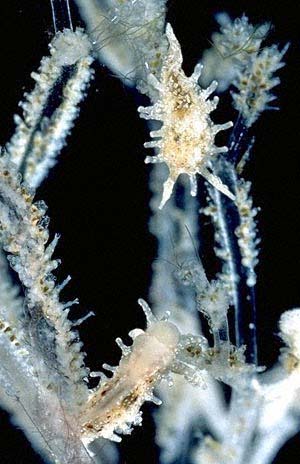
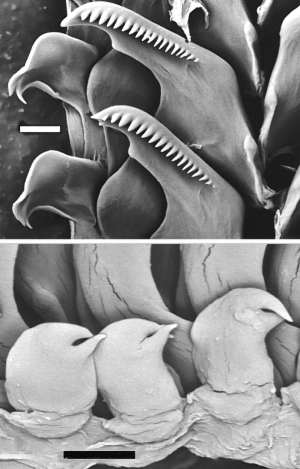
The animal illustrated here was previously identified on the Forum as Okenia mija but I recently showed that its differs anatomically (Rudman, 2004) and is most probably Okenia zoobotryon (Smallwood, 1910) which was originally described from the Caribbean region of the western Atlantic and has since been reported from Brazil and the Canary Islands.
PHOTOS: Upper: on bryozoan Zoobotryon verticillatum, Point Turton Jetty, Yorke Peninsula, SA, , 3m, 19 February 1985, many hundreds seen, approx 50 specimens collected, 4-6mm long, AM C145165. Photo: Bill Rudman. Lower: SEM photos of radula. showing section of left side of radula, and close-up 3 outer lateral teeth. Point Turton, Yorke Peninsula, South Australia, 19 February 1985, on wharf piles and rocks, AM
C145165. Scale bar = 10 µm. Photo: G. Avern.
The animal were small and elongate with a distinct mantle edge bearing a series of lateral papillae which are slightly swollen and rounded at the tip. There are approximately 6 papillae on each side, including an anterior pair in front of the rhinophores. There are also a pair of dorsal papillae in the midline, one just in front of the gills and one just behind the rhinophores. I could find no sign of other papillae on the dorsum. The rhinophores are about twice the length of the lateral papillae and have 3 characteristic cup shape structures on the posterior side of the upper half. The body is translucent straw in colour with a speckling all over of opaque white. There are microscopic brown spots scattered all over the body and also a few larger darker brown spots as well. The lateral papillae are translucent clear with scattered opaque white patches. The rhinophores are also translucent clear but the white patches are mainly confined to the edge of the cup shaped 'lamellae' and the tip.
The radula is fairly typical for the Family Gonidorididae with a large denticulate inner lateral tooth and a small outer tooth on each side of each row. The formula was 23-5 x 1.1.0.1.1. The innermost tooth has a broad base and a long elongate pointed cusp with many (22+) narrow, relatively long, pointed denticles along the cutting edge. The much smaller outer teeth have a broad quadrangular base with a large recurved bicuspid tip.
As I discuss on the species Fact Sheet, it is very difficult to be sure that these animals from southern Australia are the same as O. zoobotryon from the Atlantic, because there are many features of the Atlantric animal which have not yet been clealry described. In general external shape and colour they agree, and they have the characteristic cup-shape lamellae on the rhinophores, but they lack secondary dorsal papillae which are characteristic of Atlantic specimens of O. zoobotryon. The obvious zoogeographic anomaly is not a major obstacle because its food bryozoan, the ctenostome Zoobotryon verticillatum (= Z. pellucidum) is a well-known 'tramp' species, with a worldwide distribution considered to be the result of shipping and perhaps drifting on pieces of brown algae. Okenia pellucida, also a feeder on Zoobotryon verticillatum, has a wide distribution which is also considered, at least partially, to be the result of the 'unnatural' distribution of Zoobotryon.
- Rudman, W.B. (2004) Further species of the opisthobranch genus Okenia (Nudibranchia: Goniodorididae) from the Indo-West Pacific. Zootaxa, 695: 1-70.
Bill Rudman
Rudman, W.B., 2004 (Dec 21) First record of Okenia zoobotryon from Australia. [Message in] Sea Slug Forum. Australian Museum, Sydney. Available from http://www.seaslugforum.net/find/12656Okenia zoobotryon? from Senegal
March 8, 2004
From: Marina Poddubetskaia
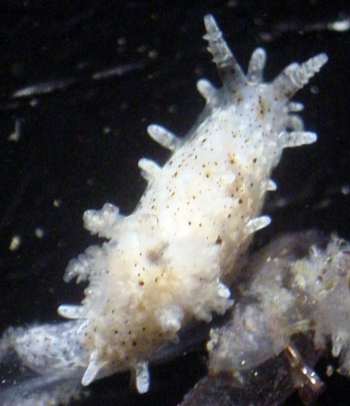
Dear Bill,
Here is a mystery from Dakar. I have no idea what species it is. The general shape makes me think a little about Aegires. I found several animals on a bryozoan (see the joined photo). According to Patrice Petit de Voize it could be Bowerbankia sp. Animals were photographed in the tank on this bryozoan.
Date: May 29, 2003
Location: Dakar, Senegal, Eastern Atlantic
Site: Ile de Goree
Depth: 8m
Size: 7-8mm
Photos: Marina Poddubetskaia - Nembro website
Thank you in advance for your help.
Best wishes,
Marina.
nembro@nembro.info
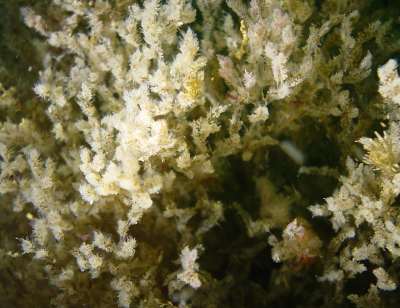
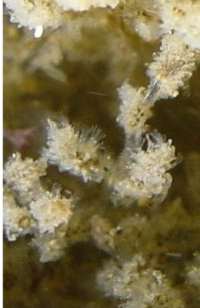
Dear Marina,
Here is a message from west Africa you sent some time ago. I first thought I woud post it as a change from your interesting Caribbean material, but I suspect it is a direct link to that fauna as well. At first I tried to find a European species of Okenia that matches, and then I realised it is almost certainly the Caribbean Okenia zoobotryon.
It fits Smallwood's original description well and also Clark's (1984) discussion. It hs the distinctive cup-shaped lamellae on the posrterior side of the rhinophores, and I am pretty sure the bryozoan you found your animal on is Zoobotryon verticillatum, which is the known food of this species.
Valdes & Ortea (1995) describe the mantle papillae as having a rounded terminal bulb, as can be seen in Kerry Clark's small photo on the Fact Sheet. Your photo does not show this. I don't know id that is significant or whether the papillae change shape as in many aeolids. If anyone can give me feedback on this species it would be very welcome. If this is Okenia zoobotryon, it is the first record I know of from the east Atlantic.
Best wishes
Bill Rudman
Distribution of Okenia zoobotryon
July 31, 1998
From: Andy Cohen
Alana,
Okenia plana, an introduced Japanese nudibranch, is sometimes common in San Francisco Bay. Zoobotryon verticillatum has been collected twice in San Francisco Bay (in 1992 and 1997, at two different sites, and not subsequently found at either site). I've usually found O. plana and its egg masses on Conopeum cf. tenuissimum, an encrusting membraniporine bryozoan--the same or very similar species has been reported from Indian River Lagoon (e.g. Winston 1995 Bull Mar Sci 57(1): 84-93). The cheilostome Conopeum is not closely related to the ctenostome Zoobotryon.
Z. verticillatum is probably an introduced organism in much of its range--probably transported attached to the hulls of ships--and as Bill Rudman points out, O. zoobotryon would be a likely candidate for globe-trotting as well.
Can you tell me, what is O. zoobotryon's distribution? Is it found only on Zoobotryon?
Andy Cohen
acohen@sfei.org
Cohen, A., 1998 (Jul 31) Distribution of Okenia zoobotryon. [Message in] Sea Slug Forum. Australian Museum, Sydney. Available from http://www.seaslugforum.net/find/183Have a look at my comments on Hopkinsia plana... Bill Rudman.
Re: Working on Okenia zoobotryon
May 18, 1998
From: Dr Kerry B. Clark

Bill,
There's a shot of Okenia zoobotryon at:
http://members.aol.com/westaslugs/Doridnudis.html
This site's not quite finished, but you can use the image on your site if you like.
Kerry
Dr Kerry B. Clark
Florida Institute of Technology
Melbourne, Florida
USA
kclark@iu.net
Clark, K.B, 1998 (May 18) Re: Working on Okenia zoobotryon. [Message in] Sea Slug Forum. Australian Museum, Sydney. Available from http://www.seaslugforum.net/find/169Thanks Kerry, look forward to seeing your site on West Atlantic opisthobranchs finished....Bill Rudman.
Working on Okenia zoobotryon
April 9, 1998
From: Alana Synhoff
I am a graduate student at UCF and I am working on Okenia zoobotryon, a small dorid nudibranch found in the Indian River Lagoon (east coast of Florida near Daytona Bch, FL). Okenia zoobotryon feeds upon the bryozoan Zoobotryon verticillatum which produces a bromo-alkaloid, 2,5,6-tribromo-methylgramine which has shown to act as an antifouling substance in barnacle cyprids.
Any info on this topic would be appreciated. It appears that not much is known about O. zobotryon, and just a little more is known about Z. verticillatum. I need info on any other bromo-alkaloid relationships between slugs and their prey (even if they are not dorids). Any chemistry relationships in general would also be useful to my research.
Thanks!
Alana Synhoff
Orlando, Florida, USA
acs31332@pegasus.cc.ucf.edu
Synhoff, A., 1998 (Apr 9) Working on Okenia zoobotryon. [Message in] Sea Slug Forum. Australian Museum, Sydney. Available from http://www.seaslugforum.net/find/90If you could send me a photo of Okenia zoobotryon it would be interesting to put it on the site. I have often wondered what this apparently common little species looks like. The drawings which have been published are either of preserved animals or not that informative. Your Okenia seems to be just the sort of species which could become a world traveller, so it would be useful if we could keep an eye out for it. I suspect your bryozoan, Zoobotryon, is found here. Concerning your more specific enquiry about bromo-alkaloids, perhaps Tony Wright (a.wright@tu-bs.de), who sent a question on Reticulidia halgerda could help you
Bill Rudman
